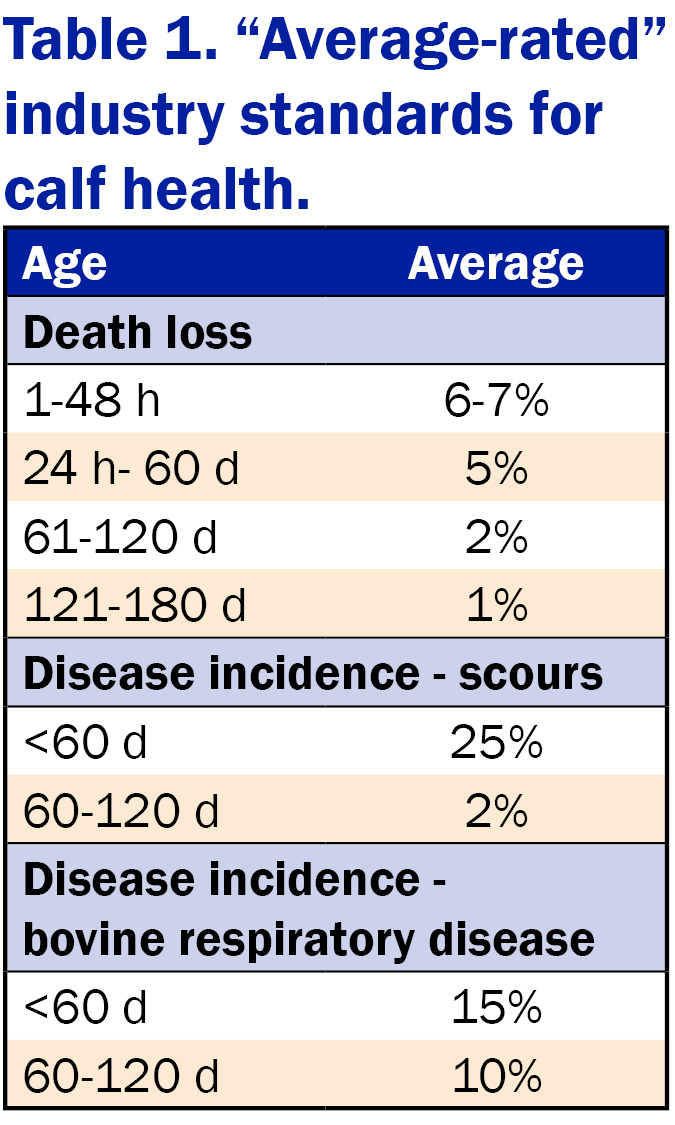
Calf Care Checklist: Benchmark Calf and Heifer Health
 By Dr. Jenn Rowntree, dairy calf and heifer specialist
By Dr. Jenn Rowntree, dairy calf and heifer specialistWhen was the last time you evaluated the performance of your dairy replacements in terms of health? Do you have a defined set of health goals on your dairy?
In addition to the performance benchmarks defined in the Dairy Calf and Heifer (DCHA) Gold Standards, consider setting goals for your farm’s calf and heifer health. Regularly compare health events with these goals to determine if they are being met consistently.
Table 1 lists “average-rated” industry standards. How well does your farm compare?

Does your farm struggle to meet the industry standards? Is your farm not meeting its specific goals? Consider focusing on these specific areas, included in DCHA’s guidelines, and determine if changes to your operation can help reach your replacement health goals.
Antibiotic use
- Maintain handwritten AND computerized records of all treatments on farm.
- Work with your veterinarian to develop farm-specific protocols for scours, pneumonia and infected umbilicus/joints.
- Review protocols when treatments are no longer effective. Involve your veterinarian and other calf team members to determine an appropriate course of action.
Colostrum management
- Use a colostrometer or refractometer to consistently measure colostrum quality.
- Deliver 4 quarts of high-quality, clean colostrum within two hours of birth and provide an additional feeding 12 hours later.
- Do you know your rate of passive transfer of immunity? Are serum total protein levels consistently above 5.5 g/dL?
Housing
- Calculate housing area per calf. This will vary by age and should be a minimum of:
- 0 to 60 days of age: 24 square feet per calf
- 60 to 120 days of age: 34 square feet per calf
- 121 to 180 days of age: 40 square feet per calf
- For group-housed calves less than 60 days old, we recommend at least 30 to 35 square feet per calf
- Is cubic feet per animal adequate to allow for optimal ventilation for heifers housed indoors?
Nutrition
- Are calves getting enough energy to support their immune systems and growth? Scours and pneumonia greatly increases calories needed to support immune function.
- Offer fresh, clean water at all times to calves older than three days of age to avoid dehydration and promote rumen development.
Transportation
- Newborn calves should be dry, able to stand, and at least 24 hours old before transporting, especially during cold weather.
Vaccinations
- Avoid giving more than two separate vaccinations simultaneously, especially when administering gram-negative bacterins.
- Maintain vaccines at the proper temperature. Never store refrigerated vaccines in the door, as wide temperature swings can occur here.
- Make sure employees are trained on proper vaccine administration and handling.
Veterinary involvement
- Set up regular team meetings outside of herd checks to discuss calf health goals and challenges.
- Review treatment protocols and effectiveness on at least an annual basis.
Finally, analyzing health records on heifers can help you determine which animals are most likely to be productive members of the lactating herd, thus improving the overall health of your herd’s future.
| Category: |
Animal health Calf and heifer nutrition Starting Strong - Calf Care |

